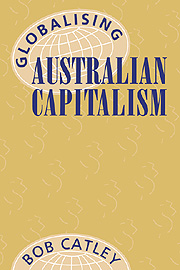Book contents
- Frontmatter
- Contents
- List of Tables
- List of Figures
- Preface and Acknowledgements
- List of Abbreviations
- Introduction
- 1 The International System and the End of the Cold War
- 2 The World Market and the Industrial Revolution in Asia
- 3 The Australian State and Economic Development
- 4 Economic Rationalism Changes Australian Politics
- 5 Government and Business in Australia
- 6 The Public Sector Reinvented
- 7 Australian Industry Restructures
- 8 Geographic Dimensions of Change
- 9 Australia Joins the Asia-Pacific Region: from ANZUS to APEC
- 10 All in a Day's Work
- Notes
- Index
7 - Australian Industry Restructures
Published online by Cambridge University Press: 14 January 2010
- Frontmatter
- Contents
- List of Tables
- List of Figures
- Preface and Acknowledgements
- List of Abbreviations
- Introduction
- 1 The International System and the End of the Cold War
- 2 The World Market and the Industrial Revolution in Asia
- 3 The Australian State and Economic Development
- 4 Economic Rationalism Changes Australian Politics
- 5 Government and Business in Australia
- 6 The Public Sector Reinvented
- 7 Australian Industry Restructures
- 8 Geographic Dimensions of Change
- 9 Australia Joins the Asia-Pacific Region: from ANZUS to APEC
- 10 All in a Day's Work
- Notes
- Index
Summary
After the economic and political crisis of 1983, which involved a severe recession and a change of government, the political elites of Australia became progressively more strongly committed to opening the Australian economy to the world market. The consequences of this policy shift were to be felt throughout the country, impinging on a wide range of social, economic and political institutions. Although acceptance of the policy among the managerial strata became more widespread, among the general public and public sector intelligentsia attacks on ‘economic rationalism’ remained common into the 1990s. This direction of policy was in fact unavoidable, though the degree to which it succeeded was in no way predetermined. Government used several macro-economic policy initiatives to drive change in the structure of the Australian economy. Their effectiveness requires analysis.
Financial Deregulation
The entry-level economic reform was the float of the dollar and the lifting of most foreign exchange controls in December 1983 and the admission of foreign banks in February 1985. Previously, as described in Chapter 3, Australian individuals and companies wishing to borrow money were either restricted to domestic lending institutions or had to receive government permission to borrow overseas. This policy change enabled them to borrow funds by either going to foreign banks operating in Australia, which could call on their international assets, or going direcdy or through Australian banks to foreign money markets. In the 1980s much of the world's saving was taking place in East Asia, and much of that in Japan. The Japanese not only had a high domestic and household savings ratio but also were adding to this by running very large annual trade surpluses, particularly with the United States.
- Type
- Chapter
- Information
- Globalising Australian Capitalism , pp. 129 - 154Publisher: Cambridge University PressPrint publication year: 1996



